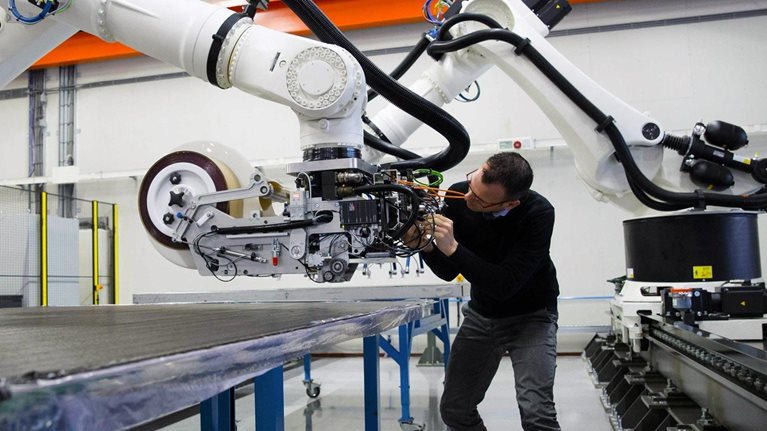Since the financial crisis of 2007–09, many companies have applied lean management to improve cost efficiencies, customer satisfaction, and employee engagement simultaneously, and many programs have achieved substantial impact on all dimensions. Progress on digital, however, has been more uneven.
In the insurance sector, for example, an October 2016 FIS study found that 99.6 percent of insurers surveyed admitted they face obstacles in implementing digital innovation, while 80 percent recognize they need digital capabilities to meet business challenges. This difficulty has been compounded by the boom in “insurtech” investments in 2016—topping $3.5 billion in funding across 111 deals since 2015.
Stay current on your favorite topics
As macroeconomic conditions continue to put pressure on profit margins across sectors, cost productivity and unlocking new value are back at the top of the senior-management agenda. The question is, what else can be done?
That’s where intelligent process automation (IPA) comes in. We believe it will be a core part of companies’ next-generation operating models. Many companies across industries have been experimenting with IPA, with impressive results:
- Automation of 50 to 70 percent of tasks . . .
- . . . which has translated into 20 to 35 percent annual run-rate cost efficiencies . . .
- . . . and a reduction in straight-through process time of 50 to 60 percent . . .
- . . . with return on investments most often in triple-digit percentages.
New technologies that promise double-digit or even triple-digit same-year returns should rightfully be viewed with skepticism. But our experience shows that the promise of IPA is real if executives carefully consider and understand the drivers of opportunity and incorporate them effectively with the other approaches and capabilities that drive the next-generation operating model. (For more on these approaches and capabilities, please read “The next-generation operating model for the digital world.”)
What is intelligent process automation?
In essence, IPA “takes the robot out of the human.” At its core, IPA is an emerging set of new technologies that combines fundamental process redesign with robotic process automation and machine learning. It is a suite of business-process improvements and next-generation tools that assists the knowledge worker by removing repetitive, replicable, and routine tasks. And it can radically improve customer journeys by simplifying interactions and speeding up processes.
IPA mimics activities carried out by humans and, over time, learns to do them even better. Traditional levers of rule-based automation are augmented with decision-making capabilities thanks to advances in deep learning and cognitive technology. The promise of IPA is radically enhanced efficiency, increased worker performance, reduction of operational risks, and improved response times and customer journey experiences.
Would you like to learn more about our Digital McKinsey Practice?
IPA in its full extent encompasses five core technologies:
- Robotic process automation (RPA): a software automation tool that automates routine tasks such as data extraction and cleaning through existing user interfaces. The robot has a user ID just like a person and can perform rules-based tasks such as accessing email and systems, performing calculations, creating documents and reports, and checking files. RPA helped one large insurance cooperative to reduce excess queue procedures affecting 2,500 high-risk accounts a day, freeing up 81 percent of FTEs to take on proactive account-management positions instead.
- Smart workflow: a process-management software tool that integrates tasks performed by groups of humans and machines (for instance, by sitting on top of RPA to help manage the process). This allows users to initiate and track the status of an end-to-end process in real time; the software will manage handoffs between different groups, including between robots and human users, and provide statistical data on bottlenecks.
- Machine learning/advanced analytics: algorithms that identify patterns in structured data, such as daily performance data, through “supervised” and “unsupervised” learning. Supervised algorithms learn from structured data sets of inputs and outputs before beginning to make predictions based on new inputs on their own. Unsupervised algorithms observe structured data and begin to provide insights on recognized patterns. Machine learning and advanced analytics could be a game changer for insurers, for example, in the race to improve compliance, reduce cost structures, and gain a competitive advantage from new insights. Advanced analytics has already been implemented extensively in leading HR groups to determine and assess key attributes in leaders and managers so as to better predict behaviors, develop career paths, and plan leadership succession.
- Natural-language generation (NLG): software engines that create seamless interactions between humans and technology by following rules to translate observations from data into prose. Broadcasters have been using natural-language generation to draft stories about games in real time. Structured performance data can be piped into a natural-language engine to write internal and external management reports automatically. NLG has been used by a major financial institution to replicate its weekly management reports.
- Cognitive agents: technologies that combine machine learning and natural-language generation to build a completely virtual workforce (or “agent”) that is capable of executing tasks, communicating, learning from data sets, and even making decisions based on “emotion detection.” Cognitive agents can be used to support employees and customers over the phone or via chat, such as in employee service centers. A UK auto insurer that uses cognitive technology saw a 22 percent increase in conversion rates, a 40 percent reduction in validation errors, and a 330 percent overall return on investment.
What might IPA look like in action? Let’s take an insurance company where a human claims processor pulls data from 13 disparate systems to provide a “business as usual” service.
With IPA, robots can replace manual clicks (RPA), interpret text-heavy communications (NLG), make rule-based decisions that don’t have to be preprogrammed (machine learning), offer customers suggestions (cognitive agents), and provide real-time tracking of handoffs between systems and people (smart workflows).
The value of IPA
While IPA takes over rote tasks, human workers can focus on delighting customers and thinking about how new troves of data outside the organization—from news, events, social media, embedded sensors, and elsewhere—can help achieve business goals.
Although the full range of benefits comes from implementing the complete IPA suite, companies can unlock significant value quickly through individual elements. RPA alone can drive significant productivity gains, as Exhibit 1 shows.

One large financial institution used an RPA transformation at scale to automate 60 to 70 percent of tasks in record-to-report processes and create annual run-rate efficiencies of 30 percent or more. Using the same methodology, another institution achieved an 80 percent reduction in processing costs in excess queue procedures. Yet another financial institution in the FT500 used robotics to unlock a £175 million annual reduction in costs and save over 120 FTEs.
In addition, IPA helps leaders get the most out of decades of investments in a multitude of complex systems and make many complicated decisions simultaneously. We have also seen businesses insert controls to activate additional processes triggered by new discoveries in real time. Creating an unsupervised machine-learning platform coupled with a natural-language generation engine, for example, will soon allow the processing of structured daily performance data to create deep insights that help leaders make better decisions, while shifting internal management processes at the same time. No longer will painful-to-create reports with limited functionality be required, only to pile up on desks. In the insurance industry particularly, there are areas where IPA could have massive impact.
How to get started on your IPA transformation
IPA does not require a significant infrastructure investment since it addresses the presentation layer of information systems. RPA software, for example, sits on top of existing systems, enabling it to be implemented to achieve rapid returns without changing the IT back end. In some cases, companies can get RPA systems up and running—and delivering value—in as little as two weeks.
In our experience, the following steps are the most important in driving successful IPA transformations at scale:
1. Rapidly align on IPA’s role in operating model
Any effective IPA initiative must be grounded in a clear understanding of the overall strategy of the business and the role of the next-generation operating model in helping to achieve it. That requires a clear articulation of the target end state and the journeys to focus on to reach it. Such clarity allows business leaders to evaluate and align on the approaches and capabilities to implement to drive the operating model. In many cases IPA has an important—even dominant—role in driving the change, but its greatest value comes when companies understand how it can work with the other capabilities and approaches in the operating model. Automation is coming, and now is the time to define the art of the possible and apply it strategically where it makes most sense.
2. Design around the full portfolio of IPA solutions to maximize impact
Organizations should not dabble with a few IPA technologies. The world moves too quickly for that approach to work effectively. The full impact comes when IPA technologies work together.
Organizations need to envision and implement holistic optimization programs to maximize return on investment. Though it is easier and faster to implement automation projects in silos, such an approach is inherently flawed. By themselves, individual technologies are insufficient to capture value. Instead, fundamental process redesign is required to transform the way a group works.
A detailed roadmap for implementation should be created to identify all automation-enhancement opportunities and allow businesses to sequence IPA initiatives by balancing their impact with the feasibility of scaling solutions from initial use cases. Start your IPA journey by rapidly creating an overview of current tasks and the resources and capabilities needed to carry them out. Then deploy an experienced ring-fenced incubator team to redesign processes and group workflows based on a deep understanding of lines of business and IPA capabilities.
3. Build a rapid minimum viable product (MVP)
Even though it’s important to design for a full IPA portfolio, it can be daunting to start working on everything at once. Many executives have been burned by promising complex data-warehouse projects, some of which have taken up to a decade to complete and have run vastly over budget. As with other digitization efforts, it’s better to select—with a bias to speed and impact—an end-to-end process or customer journey to redesign and enhance using IPA, and then work to launch an MVP, the most stripped-down version of the product that can still accomplish the task. In this way, you can quickly test what works and what doesn’t and make changes accordingly.
IPA can deliver tangible value in weeks rather than years in the form of fewer errors and less “busy work” for back-office employees. The rapid returns from early pilots help to secure support from stakeholders and executive sponsors for a much deeper program to harness the potential achievable from a full IPA transformation.
4. Build momentum and capture value
Any IPA implementation should combine quick wins with larger longer-term developments. The detailed roadmap should be rooted in a fundamental process redesign that sequences automated modules for production and reimagines the way groups should work to capture value.
Every product line in insurance, for example, has a different degree of potential for standardization and automation, and needs to be examined and sequenced (Exhibit 2). Look at time-intensive processes in sales, underwriting and pricing, policy administration, claims and finance, and accounts, and start with a clean sheet when deciding how they will work in future.

5. Embed lasting capabilities to achieve sustainability
One successful way to sustain value creation is by creating a center of excellence (CoE) to govern the transformation and support the rapid deployment of IPA solutions through capability building, certification and standards, vendor management, and the creation of a library of reusable solution patterns. Such a CoE should be centrally located and can be fairly small in size because it can call on existing lean or process-optimization CoEs, while business ownership and execution should sit in the lines of business or in digital factories.
Systematic controls need to be in place, and organizations should embed critical business-analysis and digital skills in lines of business so that they can own the process. They also need to redesign organizational structures to capture value, establish a future-state operating model to scale up their IPA initiatives, create blueprints for future structures to capture impact and embed new capabilities, and offer training and workshops to explain why the automation of manual processes will free up teams to focus on more creative activities.

The next-generation operating model for the digital age
It’s crucial to engage your business and your functional teams in the process—for example, by building bots—and to establish reusable assets such as playbooks. The most successful way to build lasting IPA capabilities is through a learn-by-doing approach that combines coaching, on-the-job training, and knowledge sharing. To capture value at enterprise scale, organizations need people with deep skills in IPA levers, process redesign, and lean principles as well as domain expertise. Technology skills alone will not be sufficient. Many organizations opt to bring in external support to supplement their talent pool and accelerate the transformation of the enterprise.
6. Carefully coordinate change management and communications
As in any large transformation program, a robust communications plan will be required to help manage redeployment, generate excitement, and align the change story with corporate strategy. Success in establishing the new execution model will depend on how far it is aligned with the organization’s culture and how well people are able to adapt to agile practices. In addition, change champions will need to be developed internally to make the transformation a success.
Companies are using IPA to invest in and develop new platforms, engage with customers, and win over advisors, all at a dramatically lower cost. But companies are only scratching the surface of what is possible. Tomorrow’s winners are those that embrace these capabilities as part of a next-generation operating model and move quickly to capture the value from them, pulling away from the laggards who choose to dip in only one toe at a time.

